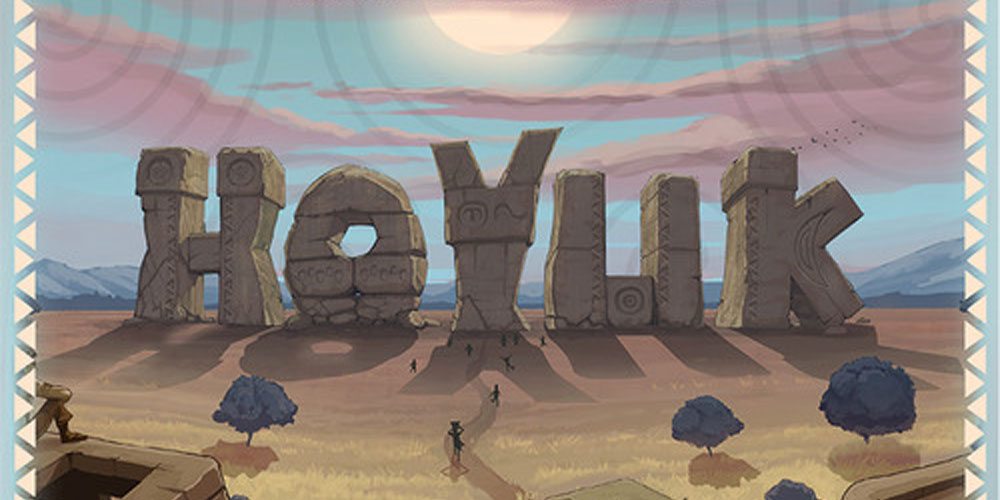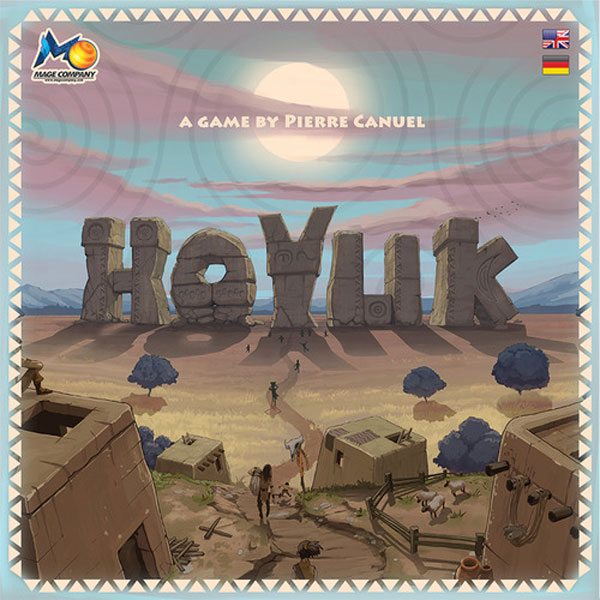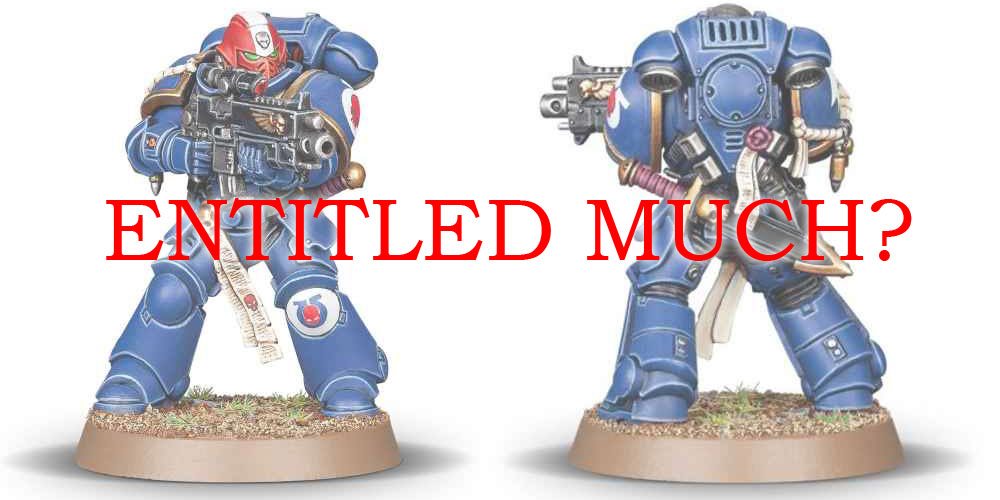10,000 years ago in the region of Anatolia in what is now the Middle East, early civilizations began to take root–hunter-gatherers settled down and started farming. Clans came together and built settlements. But life was not without disasters: floods, droughts, earthquakes, and famines had sometimes devastating consequences. In Hoyuk, you play a Neolithic clan, eager to establish your family in this emerging community.
At a glance: Hoyuk is for 2 to 5 players, ages 10 and up, and takes about an hour to play. It retails for about $55. It was funded last year through a Kickstarter campaign and has since been delivered, and there is currently a campaign for an expansion right now (which does include the base game in some reward levels).
New to Kickstarter? Check out our crowdfunding primer.

Components:
- 1 game board
- 5 player score tokens
- 1 125 house tiles (25 each in 5 colors)
- 40 pen tiles
- 20 oven meeples
- 20 shrine meeples
- 20 villager meeples
- 20 cattle meeples
- 1 shaman meeple
- 1 first player tile
- 15 construction board tiles
- 24 catastrophe cards
- 70 aspect cards
The board is quite large: it’s a 6-fold board with a large gridded map in the center, a scoring track around that, and then some areas on either side for the aspect cards, meeple supplies, and the construction board tiles. There’s a small turn order reference in the bottom corner, but it can be a little hard to interpret.
The game itself is language independent–there are rulebooks in English, French, and German included, but the game pieces themselves have no text whatsoever, just numbers and icons. The difficulty, though, is that the icons aren’t always very intuitive, and in some cases inconsistent. For instance, take the ovens. The meeple is a little grey trapezoid–some of my friends thought it was an upside-down minecart. The place where you store the ovens has an illustration of what looks more like a little carved-out white stone with a fire in it. But the icon used for the oven on the aspect cards and the construction tiles is a green igloo sort of thing. And then on the catastrophe cards it’s yet another icon. At least most of the printed ones are similar round shapes–but the meeple doesn’t match them.

The shrine also suffers the same issue: the meeple doesn’t really look like the illustration on the cards and the board, and there are three different illustrations or icons that don’t all match each other. The cattle meeple (which I assume is meant to look sort of like a buffalo) looks more like a misshapen camel. Once you know what things are, it’s not a huge deal, but it does seem kind of odd that they didn’t just use a consistent icon for each thing.
The board looks nice, though. The map area has an illustration of land, with trees and a river, though none of the background really matters for the base game. The whole thing has a checkerboard shading to it so that there’s a grid on the map.
The cardboard pieces are all pretty nice–good sturdy cardboard, and they punched out cleanly. Each player color has a different style of house pictured on the tiles, which adds a little variety visually. The wooden pieces are fine and they work, but they just don’t look exactly like the things they’re supposed to represent.

How to play
The rulebook is available here as a PDF.
The goal of the game is to score the most points, which can be earned through a variety of ways: building houses, ovens, shrines, and cattle pens, as well as having villagers and cattle.
The game can be played in three modes: basic, medium, and advanced. The modes are fairly similar, but introduce more features to keep track of. I’ll give an overview of the basic game, and then mention the additional elements added in medium and advanced modes.

To set up, each player takes all the house tiles of one color. The shrine and oven meeples and the pen tiles are set in the designated areas of the board. Scoring markers are all placed at 0 on the scoring track. Catastrophe cards are shuffled and placed in the catastrophe area. Aspect cards are shuffled and are placed in the aspect card area–in the basic game, you only use the oven, shrine, and pen areas. (Depending on the mode, you’ll use a subset of the catastrophe cards and aspect cards.) Construction tiles are shuffled and placed facedown on the board. Choose a player to be first player.
Each round has these phases:
- Construction (twice)
- Catastrophes (skip this in the first round)
- Aspect Cards
- End of Round
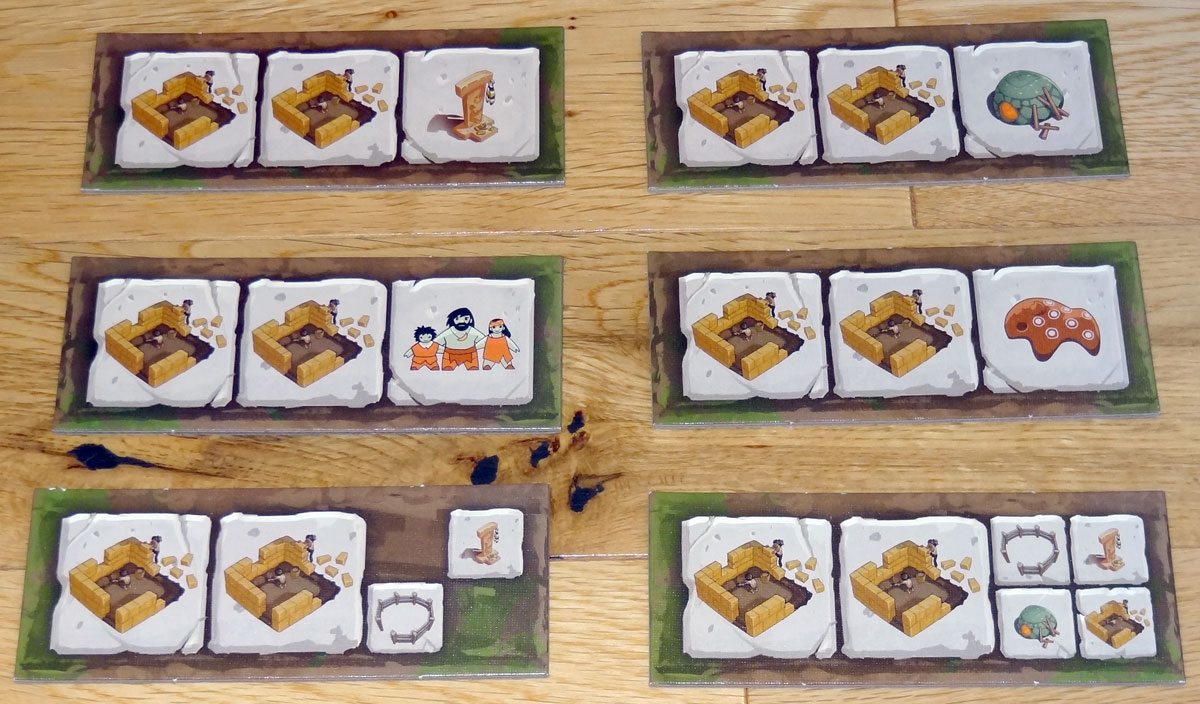
Construction: Each player gets a construction tile, which shows three elements. The first two are always houses, and the third could be another house, a shrine, an oven, or sometimes a choice of two or four things. In player order, each player builds all three elements (in the order shown). This step is then repeated, with each player getting a new construction tile.
There are various rules for placement of houses and elements that I won’t get into, but you can build 1- or 2-story houses, and you can place ovens or shrines in them (but not both). You can also attach pens adjacent to the houses. Groups of houses are “blocks,” and within a block a group of houses of the same color is a “family.”

Catastrophes: Starting in the second round, the first player will draw and resolve one catastrophe card. The card indicates what block (or blocks) are affected, and what the consequence is. It may be the block with the most ovens, the largest block, the block with the fewest pens, and so on. The most common effect is to lose houses, but there are disasters that can affect shrines or ovens as well.

Aspect cards: After resolving the catastrophe, each block is inspected and aspect cards are awarded. For each block, you will check which player has the most ovens, the most shrines, and the most pens; the winner of each aspect will take the top card from the designated pile. Note: if a block only has one player in it, then that block will not be inspected. Ties are broken by 2-story houses; in case of further ties, nobody wins the card. Players will take turns choosing which block to inspect until all blocks have been inspected.
Aspect cards may be spent in two ways, to build additional elements or to score victory points. They may be played at the beginning of each of the four phases in a round, and each time you may only play as many cards as you have different families (clusters of houses) on the board.
To build additional elements, simply spend the cards and then build the elements shown in the top left corner of the cards. (Wild cards may be spent to build any element of your choice.) To use the cards for points, you score a number of points based on the number of cards that share the same element in the top corner. So if you turn in three “oven” cards, you will get 5 points (as indicated by the chart on the card). If you turn in three cards showing different elements, they are each worth 1 point. Note that only the icon in the top corner matters for matching–the large background image is simply there for thematic purposes.
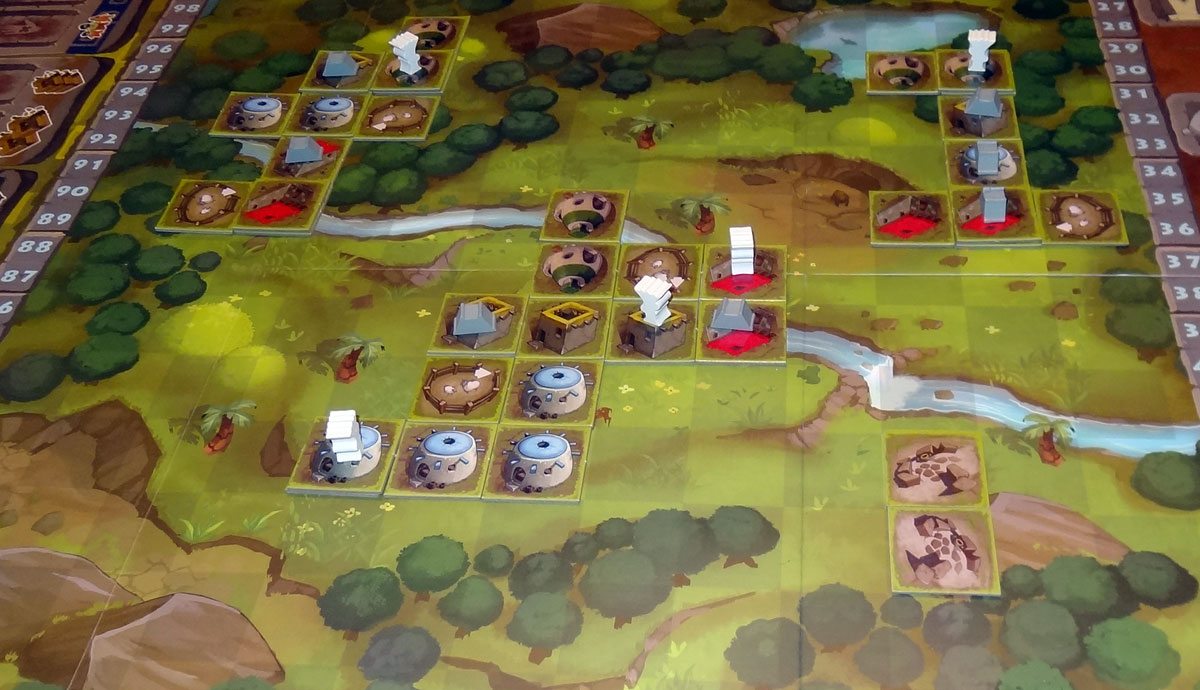
End of Round: Starting with first player, each player gathers all the aspect cards played during that round, and places them on the bottom of one of the aspect card decks. If any of the decks is empty (showing the red hand on the board), then cards may not be placed in that deck. After all players have returned spent aspect cards, the first player chooses another player to take the first player marker and the next round begins.
The game ends in the round when somebody uses their last house tile. The round is finished. All aspect cards left in your hand are worth 1 point each–no group bonuses apply. Finally, there is one last inspection of each block. The player with the largest family in each block gets one point per house in that family. The highest score wins–ties go to the player with more 2-story houses.
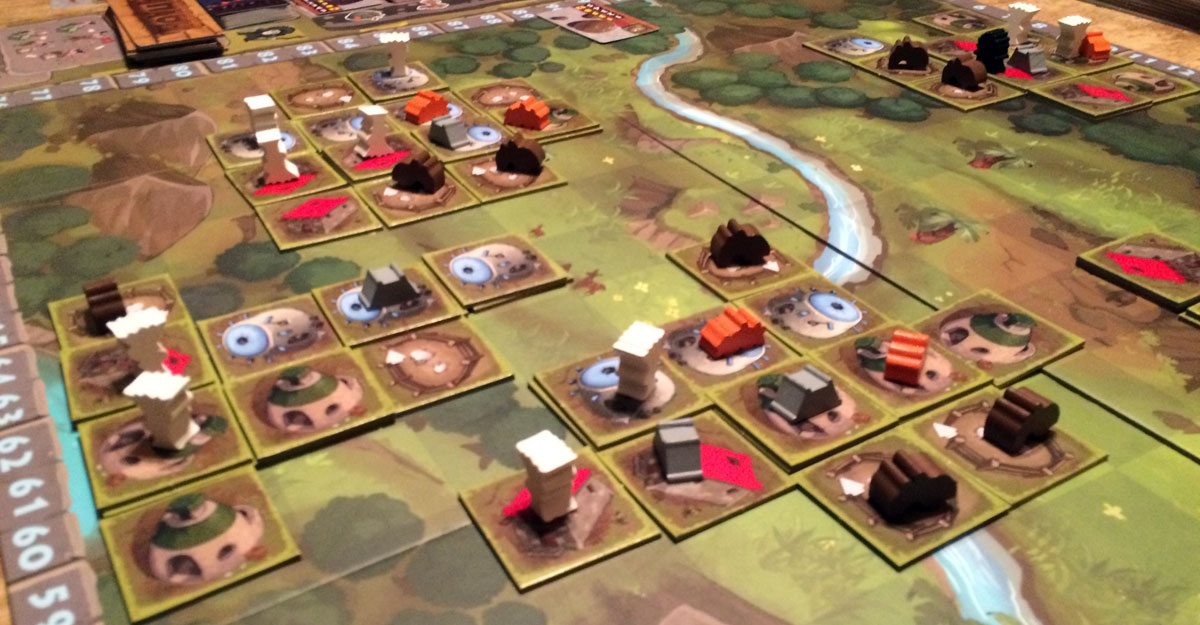
In the medium game, you will use two more slots on the aspect area of the board, awarding aspect cards to the player with the most two-story house and the most houses total in each block. (There will be some aspect cards added to the total.) In the advanced game, you’ll add the last two spots, for villagers and cattle. Now you may start placing villagers in houses and cattle in pens, and those will also award aspect cards. Of course, there are also added disasters that may affect all of these new elements.

Finally, in the advanced game you also use the Shaman. If your construction tile shows the Shaman, it lets you place the Shaman meeple on any block of your choice, protecting it from disaster. The Shaman remains there unless another player moves it, or it is actually used to prevent a catastrophe from occurring.
There is an optional rule for Clan Powers that can be used in the advanced game. Each color has a special ability that may be used whenever you turn in 5 aspect cards of the same icon for scoring. First, you score the 12 points as usual for those cards, and then you use your ability.
The Verdict
Hoyuk is a nice tile-laying game that isn’t too hard to learn but still gives you a variety of strategic options on your turn. There’s a slight bit of cooperation, since you need to be in a block with other players in order to score aspect cards–but once you’ve started building your homes near somebody, you want to have more of everything than they do. What’s the good of having a bunch of stuff if you can’t show it off to your neighbors, right? A bit like real life, I suppose.
There’s a mixture of direct and indirect competition, too. One type of direct competition comes just in cutting off areas for your opponents to build. There are various rules about how and where you can build houses, pens, and second-story houses, so it’s possible to cut a player off so they can’t expand any further in a particular block. And, of course, there are often races to have the most of any particular element in a block. For each block, you need to decide if you want to compete for the most ovens, or maybe give up the oven race and build shrines or pens instead. In the advanced game, there are even more elements to take into consideration, so you could let one aspect go and still gain cards for multiple other aspects.
The indirect competition comes in collecting cards. The aspect cards are all face-up in the decks, so you can see the top card of each stack. Since players take turns choosing which blocks to inspect, there is a little bit of strategy in selecting blocks in such a way that you’ll get the types of cards that you want. You might be looking for more shrine cards so that you can use them for building extra shrines. Or you might want to collect more oven cards because you already have some and you want to turn them in for points.
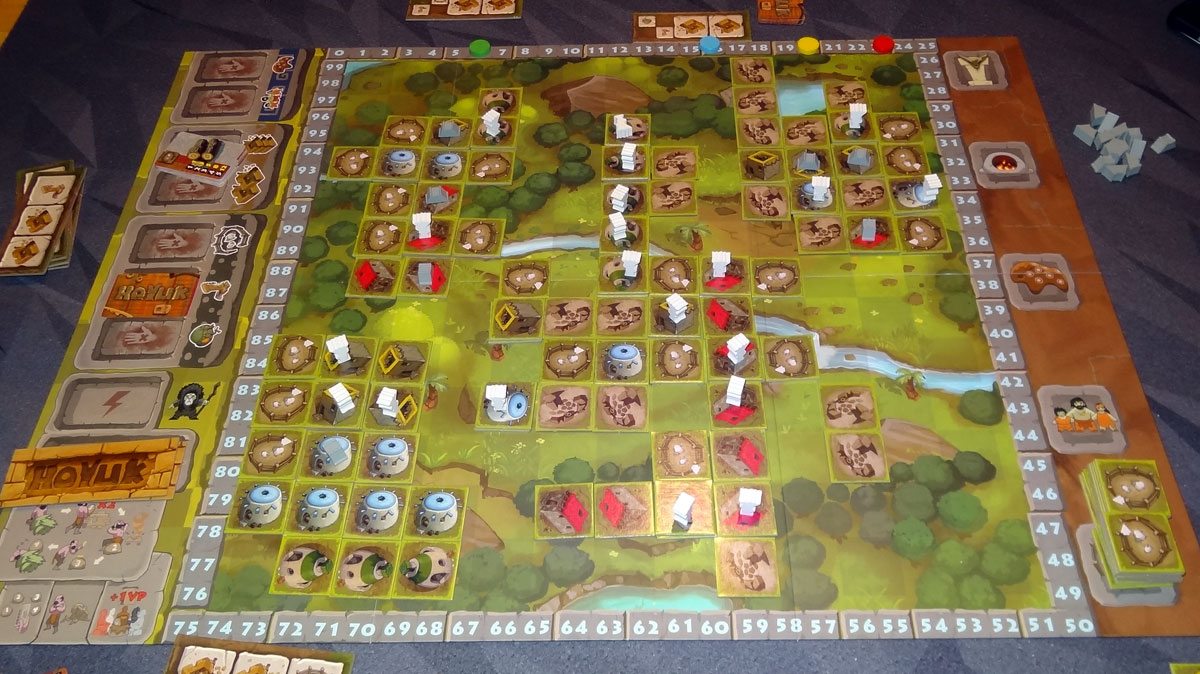
You also have to keep in mind the number of cards left in each stack–cards that are spent during the round go back into the stacks, but once a stack has been depleted, it can no longer be refilled. In one game, I had managed to do pretty well with ovens, and was winning the oven race in several blocks, which let me draw a couple of cards each round. The problem, though, was that nobody had been spending cards, and then the oven deck ran out. There I was, with a bunch of ovens that were now completely useless. You generally have to play it at least once before you realize the balance of spending cards early enough so that you’ll be able to refill the deck before it’s time to collect cards again. Sure, you’ll get more points short-term if you can just get one more card of that element … but if the supply runs out, then that’s the last of the points from that source.
On the downsides of Hoyuk, I’ve already mentioned the somewhat weird iconography and illustrations, though that’s something that is pretty easy to get used to. The other, though, is that the disasters can be less effective than expected. In the basic game, you use a smaller subset of disasters, which are triggered based on number of houses, two-story houses, pens, shrines, and ovens. Since you don’t use villagers or cattle in the basic game, disasters triggered by (or affecting) those elements are left out. Since there are a limited number of things you can build, if a disaster strikes a block and you have houses there, chances are you will be affected by it.
Once you get to the advanced game, though, there are even more things you could build in your houses, and lots of other types of disasters. The problem is, the block that is affected by the disaster might not include any of the affected elements. For instance, one Wolves disaster affects the smallest block–all players there lose half their ovens. But if that small block has no ovens, then nothing happens. Because of coincidences and lucky draws, in one advanced game I think the entire game we managed to lose only a couple cattle and maybe a house or two. The disasters just didn’t retain the ability to strike fear into us.
Despite that, though, I do recommend moving to the advanced game as soon as possible. Having more elements to build just spreads out the points a little more, and gives you other ways to compete rather than having to fight somebody on ovens and shrines. It’s not really that much more complicated, since the rules (for the most part) are still the same.
Overall, I did enjoy playing Hoyuk and I think there are still some tactics I haven’t tried out that I’d be interested in exploring further. Despite my complaints about the weird icons, the game is nice to look at, and it’s always fun to see the final village at the end.
Hoyuk is available in stores now. The expansion, Anatolia, has just about a week left on Kickstarter. I got a print-and-play prototype a little too late to do a full write-up, but it adds three new goals to the game–you choose two of them to work on, and if you achieve them by the end of the game, you could earn a lot of extra points. If you’re interested in Hoyuk, you can also get a copy of the base game included in your pledge.
Disclosure: GeekDad received a review copy of Hoyuk.
